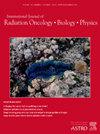Neoadjuvant and Adjuvant Pembrolizumab (Pembro) Plus Standard of Care (SOC) in Resectable Locally Advanced Head and Neck Squamous Cell Carcinoma (LA HNSCC): Postoperative Risk Subgroup Analysis of KEYNOTE-689
IF 6.5
1区 医学
Q1 ONCOLOGY
International Journal of Radiation Oncology Biology Physics
Pub Date : 2025-10-14
DOI:10.1016/j.ijrobp.2025.08.038
引用次数: 0
Abstract
Purpose/Objective(s)
The addition of neoadjuvant and adjuvant (starting concurrently with postoperative radiotherapy [PORT] ± cisplatin) pembro to SOC significantly improved event-free survival (EFS) vs SOC alone for participants (pts) with resectable LA HNSCC in the randomized phase 3 KEYNOTE-689 study (NCT03765918). We present a subgroup analysis by postoperative pathological features.
Materials/Methods
Pts had resectable SCC of the oral cavity/larynx/hypopharynx (stage III/IVA) or oropharynx (stage III/IVA p16− or stage III T4 N0-2 p16+) and were randomized 1:1 to pembro 200 mg Q3W (2 cycles neoadjuvant, 3 cycles adjuvant concurrent with PORT, 12 cycles beyond PORT) + SOC vs SOC (surgery + PORT [60 Gy in 30 fractions for low risk or 66 Gy in 33 fractions for high risk] ± 3 cycles cisplatin 100 mg/m2 Q3W [high risk only]). Postoperative pathological features by blinded independent pathologist review were based on the presence (high risk) or absence (low risk) of positive margins (<1 mm) or extranodal extension. EFS by blinded independent central review with pembro + SOC vs SOC by risk subgroups was a prespecified exploratory analysis. Formal statistical testing was not planned. As of 25 July 2024, the median follow-up for all pts was 38.3 mo (range, 9.0–66.5).
Results
Among 363 pts randomized to pembro + SOC and 351 to SOC: 321 (88.4%) and 308 (87.7%) completed surgery; 118 (32.5%) and 156 (44.4%) had presence of high-risk features, and 196 (54.0%) and 148 (42.2%) did not. 274 pts in the pembro + SOC group and 275 in the SOC group received PORT, of whom 107 and 139 pts also received concurrent cisplatin (median 3 cycles in both groups). Median (range) total PORT dose was 60.0 Gy (2.0–70.0) in the pembro + SOC group and 66.0 Gy (6.0–72.0) in the SOC group. In the high-risk subgroup, median EFS was 41.1 vs 19.5 mo, respectively (HR 0.73, 95% CI 0.52–1.05). The 3-year EFS was 52.0% vs 40.7%. Grade ≥3 TRAEs occurred in 52.1% vs 53.9% of pts. Any-cause AEs led to discontinuation of PORT in 3 pts in the pembro + SOC group and 1 pt in the SOC group. In the low-risk subgroup, median EFS was not reached vs 51.5 mo (HR 0.74, 95% CI 0.51–1.08). The 3-year EFS was 67.7% vs 58.8%. Grade ≥3 TRAEs occurred in 42.9% vs 30.4% of pts. Any-cause AEs led to discontinuation of PORT in 4 pts in the pembro + SOC group and 3 pts in the SOC group.
Conclusion
Efficacy results for pts with either presence or absence of high-risk pathological features after surgery demonstrated downgrading of pathological features with the addition of neoadjuvant and adjuvant pembro to SOC, consistent with the primary analysis of KEYNOTE-689. In the pembro + SOC group, fewer pts had high-risk pathological features and more pts received a lower radiation dose and no cisplatin. The safety profile of pembro + PORT ± cisplatin was in line with expectations.
新辅助和辅助派姆单抗(Pembrolizumab)加标准护理(SOC)治疗可切除的局部晚期头颈部鳞状细胞癌(LA HNSCC): KEYNOTE-689的术后风险亚组分析
目的/目的:在随机化的3期KEYNOTE-689研究(NCT03765918)中,与单独使用SOC相比,在SOC中加入新辅助和辅助(与术后放疗同时开始[PORT]±顺铂)可显著提高可切除LA HNSCC患者(pts)的无事件生存期(EFS)。我们根据术后病理特征进行亚组分析。材料/方法患者为可切除的口腔/喉/下咽鳞状细胞癌(III期/IVA)或口咽部鳞状细胞癌(III期/IVA p16−或III期T4 N0-2 p16+),随机分为1:1至pembro 200 mg Q3W(2个周期新辅助,3个周期辅助与PORT同时进行,12个周期超过PORT) + SOC vs SOC(手术 + PORT[低风险30分60 Gy或高风险33分66 Gy]±3个周期顺铂100 mg/m2 Q3W[仅高风险])。术后病理特征是基于阳性切缘(1mm)或结外延伸的存在(高风险)或缺失(低风险)。通过pembro + 进行盲法独立中心评价的EFS是预先指定的探索性分析,SOC与风险亚组的SOC比较。没有计划进行正式的统计检验。截至2024年7月25日,所有患者的中位随访时间为38.3个月(范围9.0-66.5)。结果在363例随机分为pembro + SOC组和351例随机分为SOC组的患者中,分别有321例(88.4%)和308例(87.7%)完成了手术;存在高危特征118例(32.5%)、156例(44.4%),无高危特征196例(54.0%)、148例(42.2%)。pembro + SOC组274名患者和SOC组275名患者接受了PORT治疗,其中107名和139名患者同时接受顺铂治疗(两组中位为3个周期)。pembro + SOC组PORT总剂量中位数(范围)为60.0 Gy (2.0-70.0), SOC组为66.0 Gy(6.0-72.0)。在高危亚组中,中位EFS分别为41.1 vs 19.5月(HR 0.73, 95% CI 0.52-1.05)。3年EFS分别为52.0%和40.7%。≥3级trae发生率分别为52.1%和53.9%。任何原因的ae导致pembro + SOC组中3例患者和SOC组中1例患者停止PORT治疗。在低风险亚组中,中位EFS未达到51.5个月(HR 0.74, 95% CI 0.51-1.08)。3年EFS分别为67.7%和58.8%。≥3级trae发生率为42.9% vs 30.4%。任何原因的ae导致pembro + SOC组中4例患者和SOC组中3例患者停止PORT治疗。结论对于术后存在或不存在高危病理特征的患者,其疗效结果表明,在SOC中加入新辅助和辅助pembro可降低病理特征,与KEYNOTE-689的初步分析一致。在pembro + SOC组中,更少的患者具有高危病理特征,更多的患者接受较低的辐射剂量和无顺铂治疗。pembroo + PORT±顺铂的安全性符合预期。
本文章由计算机程序翻译,如有差异,请以英文原文为准。
求助全文
约1分钟内获得全文
求助全文
来源期刊
CiteScore
11.00
自引率
7.10%
发文量
2538
审稿时长
6.6 weeks
期刊介绍:
International Journal of Radiation Oncology • Biology • Physics (IJROBP), known in the field as the Red Journal, publishes original laboratory and clinical investigations related to radiation oncology, radiation biology, medical physics, and both education and health policy as it relates to the field.
This journal has a particular interest in original contributions of the following types: prospective clinical trials, outcomes research, and large database interrogation. In addition, it seeks reports of high-impact innovations in single or combined modality treatment, tumor sensitization, normal tissue protection (including both precision avoidance and pharmacologic means), brachytherapy, particle irradiation, and cancer imaging. Technical advances related to dosimetry and conformal radiation treatment planning are of interest, as are basic science studies investigating tumor physiology and the molecular biology underlying cancer and normal tissue radiation response.

 求助内容:
求助内容: 应助结果提醒方式:
应助结果提醒方式:


